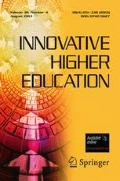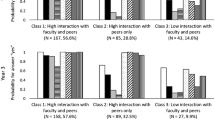Abstract
Existing explanations of faculty-student interactions emphasize social-organizational characteristics of higher education to the exclusion of social-psychological dimensions of the interactions themselves. Yet, student perceptions are essential cognitive elements that influence frequency of, and growth from, informal interaction with faculty. Drawing on a survey of students at a large public university, this paper expands theoretical understanding of faculty-student interactions by considering how social exchange theory helps explain frequency of, and growth from, informal interactions—and how such patterns vary by social identity.
Similar content being viewed by others
References
Anaya, G., & Cole, D. (2001). Latina/o student achievement: Exploring the influence of student-faculty interaction on college grades. Journal of College Student Development, 42(1), 3-14.
Barnard-Brak, L., Lechtenberger, D., & Lan, W.Y. (2010). Accommodation strategies of college students with disabilities. The Qualitative Report, 15(2): 411-429.
Bieschke, K.J., Eberz, A.B., & Wilson, D. (2000). Empirical investigations of lesbian, gay, and bisexual college students. In V.A. Wall & N.J Evans (Eds.), Toward acceptance: Sexual orientation issues on campus (pp. 31-58). Washington, DC: American College Personnel Association.
Bowman, N. A. (2010). The development of psychological well-being among first-year college students. Journal of College Student Development, 51(2), 180-200.
Calarco, J.M. (2014). Coached for the classroom: Parents’ cultural transmission and children’s reproduction of educational inequalities. American Sociological Review, 79(5), 1015-1037.
Cole, D.G. (2007). Do interracial interactions matter? An examination of student-faculty contact and intellectual self-concept. Journal of Higher Education, 78(3), 249-281.
Cole, D.G. (2010). The role of faculty contact on minority students’ educational gains. Journal of the Professoriate, 3 (2), 1–16
Cole, D.G. & Griffin, K.A. (2013). Advancing the study of student-faculty interaction: A focus on diverse students and faculty. In M.B. Paulsen (Ed.), Higher education: Handbook of theory and research (Vol. 28, pp. 561-611). Dordrecht: Springer.
Cole, D. & Espinoza, A. (2008). Improving the academic performance of Latinos in STEM majors. Journal of College Student Development, 49(4), 285-300.
Cotton, S.R., & Wilson, B. (2006). Student-faculty interactions: Dynamics and determinents. Higher Education, 51, 487-519.
Cox, B.E., McIntosh, K., Terenzini, P.T., Reason, R.D., Quaye, B.R. (2010). Pedagogical signals of faculty approachability: Factors shaping faculty-student interaction outside the classroom. Research in Higher Education, 51(8), 767-788.
Cox, B.E. & Orehovec, E. (2007). Faculty-student interactions outside the classroom: A typology from a residential college. The Review of Higher Education, 30(4), 343-362.
DeAngelo, L. (2014). Programs and practices that retain students from the first to second year: Results from a national study. New Directions for Institutional Research, (160), 53-75.
Dika, S.L. (2012. Relations with faculty as social capital for college students: Evidence from Puerto Rio. Journal of College Student Development, 53(4), 596-610.
DiRamio, D., Ackerman, R., & Mitchell, R. L. (2008). From combat to campus: Voices of student-veterans. NASPA Journal, 45(1), 73-102.
Emerson, R.M. (1981). Social exchange theory. In M. Rosenberg & R.H. Turner (Eds.), Social psychology: Sociological Perspectives (pp. 30-65). New York: Basic Books.
Einarsan, M.K. & Clarkberg, M.E. (2010). Race differences in the impact of students’ out-of-class interactions with faculty. Journal of the Professoriate, 3(2), 104-140.
Garvey, J.C. & Inkelas, K.K. (2012). Exploring relationships between sexual orientation and satisfaction with faculty and staff interactions. Journal of Homosexuality, 59(8), 1167-1190.
Greenbaum, B., Graham, S., & Scales, W. (1995). Adults with learning disabilities: Educational and social experiences during college. Exceptional Children, 61(5), 460-471.
Griffin, K.A. (2012). Black professors managing mentorship: Implications of applying social exchange frameworks to analyses of student interactions and their influence on scholarly productivity. Teachers College Record 114(5):1-37.
Hurtado, S. (1994). The institutional climate for talented Latino students. Research in Higher Education, 35(1), 21-41.
Hurtado, S. Eagan, M.K., Tran, M.C., Newman, C.B., Chang, M.J., & Velasco, P. (2011). “We do science here”: Underrepresented students’ interactions with faculty in different college contexts. Journal of Social Issues, 67(3), 553-579.
Jaeger, A. J., & Hinz, D. (2008). The effects of part-time faculty on first semester freshmen retention: A predictive model using logistic regression. Journal of College Student Retention: Research, Theory & Practice, 10(3), 265-286.
Kim, Y. K., & Lundberg, C. A. (2016). A structural model of the relationship between student–faculty interaction and cognitive skills development among college students. Research in Higher Education, 57(3), 288-309.
Kim, Y.K., Chang, M.J., and Park, J.J. (2009). Engaging with faculty: examining rates, predictors, and educational effects for Asian American undergraduates. Journal of Diversity in Higher Education, 2(4), 206-218.
Kim, Y.K., & Sax, L.J. (2009). Student-faculty interactions in research universities: differences by student gender, race, social class, and first-generation status. Research in Higher Education, 50, 437-459.
Kim, Y. K., & Sax, L. J. (2017). The impact of college students’ interactions with faculty: A review of general and conditional effects. In M.B. Paulsen (Ed.), Higher education: Handbook of theory and research (Vol. 32, pp. 85-139). Dordrecht: Springer.
Lareau, A. (2003). Unequal childhoods: Class, race, and family life. Berkeley, CA: University of California Press.
Lawler, E. J., & Yoon, J. (1996). Commitment in exchange relations: Test of a theory of relational cohesion. American Sociological Review 61(1), 89-108.
Lighthall, A. (2012). Ten things you should know about today’s student veteran. Thought & Action. Fall: 80-89.
McPherson, M.S., Smith-Lovin, L., & Cook, K. (2001). Birds of a feather: Homophily in social networks. Annual Review of Sociology, 27, 415-444.
Mayhew, M. J., & King, P. (2008). How curricular content and pedagogical strategies affect moral reasoning development in college students. Journal of Moral Education, 37(1), 17-40.
Molm, L.D (2006). The social exchange framework. In P.J. Burke (Ed.), Contemporary social psychological theories (pp. 24-45). Stanford, CA: Stanford Social Sciences.
Osborne, N. J. (2014). Veteran ally: Practical strategies for closing the military-civilian gap on campus. Innovative Higher Education, 39(3), 247-260.
Padgett, R. D., Johnson, M. P., & Pascarella, E. T. (2012). First-generation undergraduate students and the impacts of the first year of college: Additional evidence. Journal of College Student Development, 53(2), 243-266.
Pascarella, E.T., and Terenzini, P.T. (1977). Patterns of student-faculty informal interaction beyond the classroom and voluntary freshman attrition. Journal of Higher Education, 48(5), 540-552.
Pascarella, E.T., and Terenzini, P.T. (2005). How college affects students: A third decade of research (Vol. 2). San Francisco, CA: Jossey-Bass.
Quaye, S. J., Tambascia, T. P., & Talesh, R. A. (2009). Engaging racial/ethnic minority students in predominantly White classroom environments. In S. R. Harper & S. J. Quaye (Eds.), Student engagement in higher education: Theoretical perspectives and practical approaches for diverse populations (pp. 157-178). New York, NY: Routledge.
Rankin, S., & Beemyn, G. (2012). Beyond a binary: The lives of gender-nonconforming youth. About Campus: Enriching the Student Learning Experience, 17, 2–10.
Renn 2010. LGBT and queer research in higher education: State and status of the field. Educational Researcher, 39, 132-141.
Sax, L.J., Bryant, A.N., & Harper, C.E. (2005). The differential effects of student-faculty interaction on college outcomes of women and men. Journal of College Student Development, 46(6), 642-657.
Smith, B. (2007). Accessing social capital through the academic mentoring process. Equity and Excellence in Education, 40(1), 36-46.
Tinto, V. (1975). Rethinking the causes and cures of student attrition. Chicago, IL: University of Chicago Press.
Umbach, P. & Wawrzynski, M.R. (2005). Faculty do matter: The role of college faculty in student learning and engagement. Research in Higher Education, 46(2), 153-184.
Acknowledgments
The authors wish to thank Thai-Huy Nguyen for comments on an earlier version of this manuscript.
Availability of Data
Data requests may be sent to the first author at: drj@unr.edu
Funding
N/A
Author information
Authors and Affiliations
Corresponding author
Ethics declarations
Conflict of Interest
The authors declare that they have no conflict of interest.
Additional information
Publisher’s Note
Springer Nature remains neutral with regard to jurisdictional claims in published maps and institutional affiliations.
Rights and permissions
About this article
Cite this article
Johnson, D.R., Scheitle, C.P., Juvera, A. et al. A Social Exchange Perspective on Outside of Class Interactions between Underrepresented Students and Faculty. Innov High Educ 45, 489–507 (2020). https://doi.org/10.1007/s10755-020-09518-6
Published:
Issue Date:
DOI: https://doi.org/10.1007/s10755-020-09518-6




